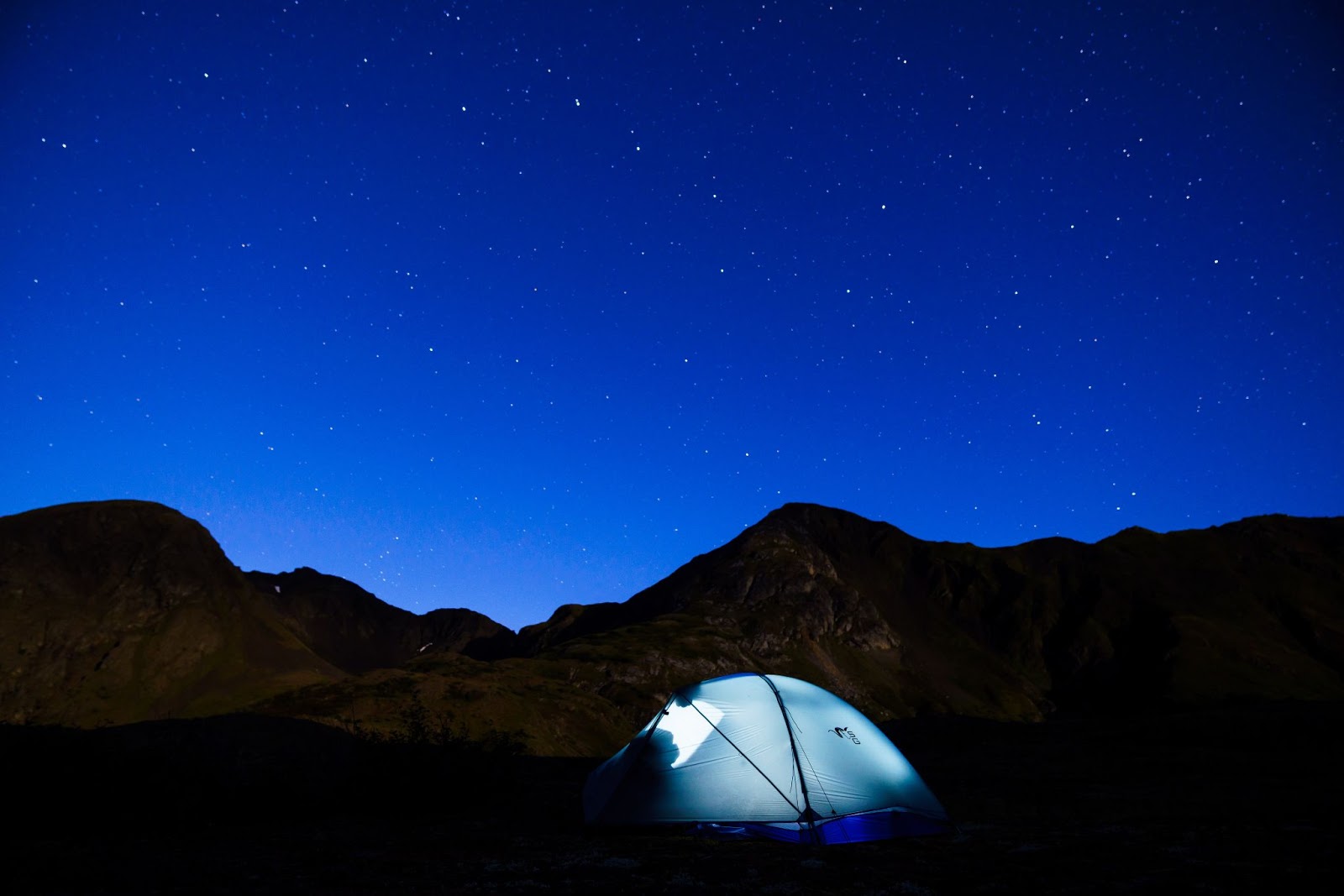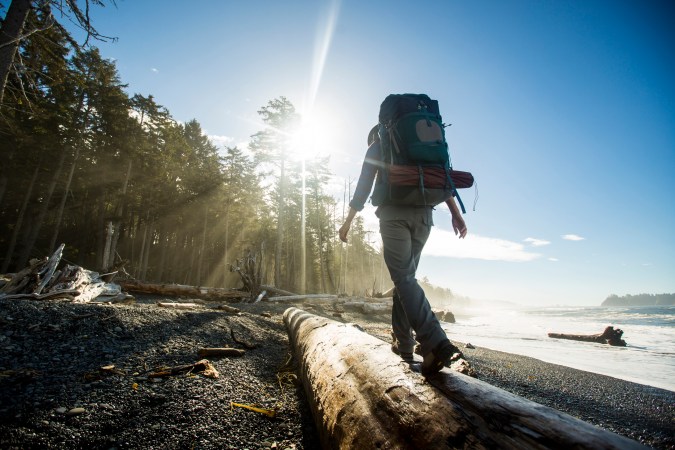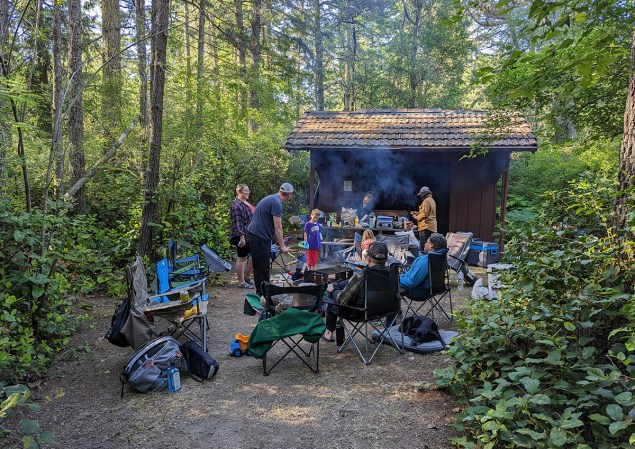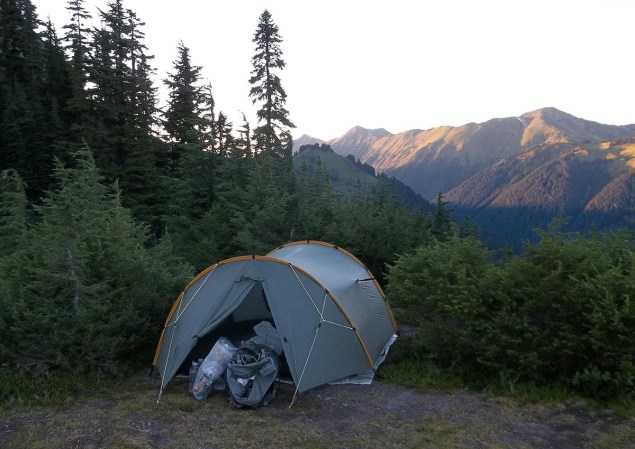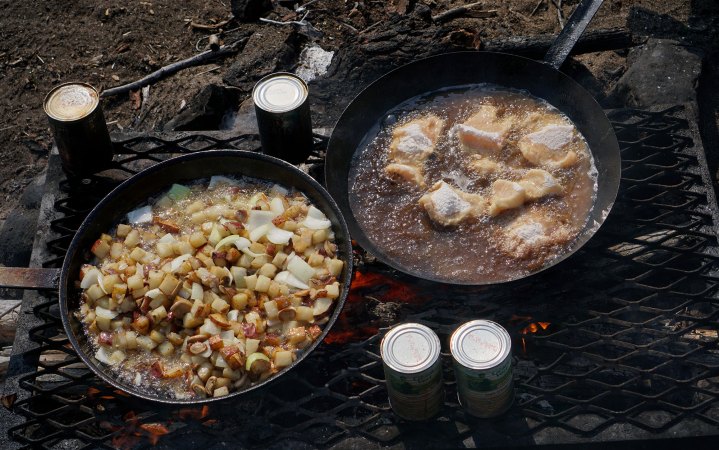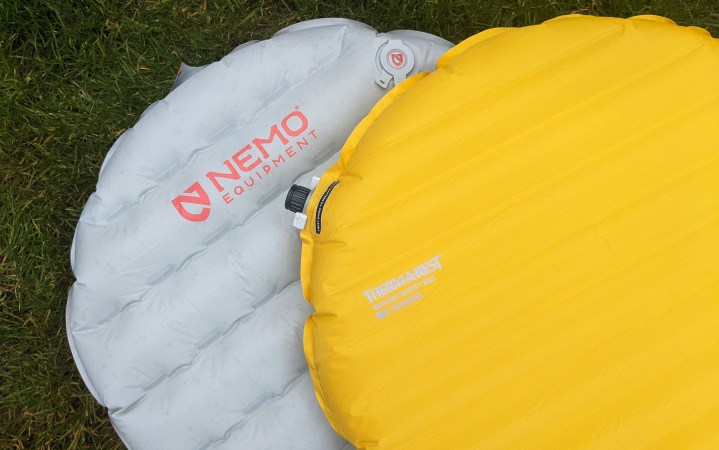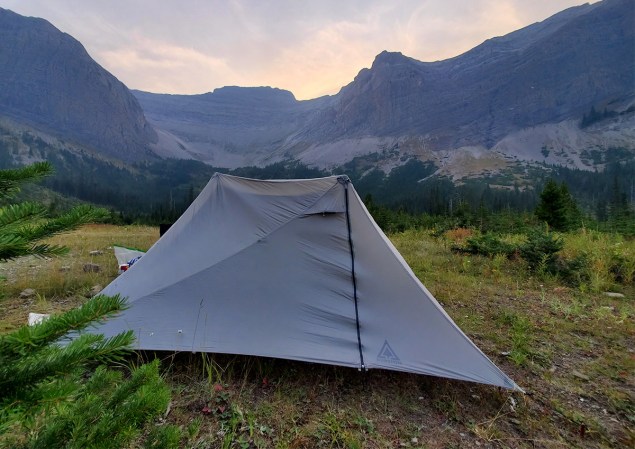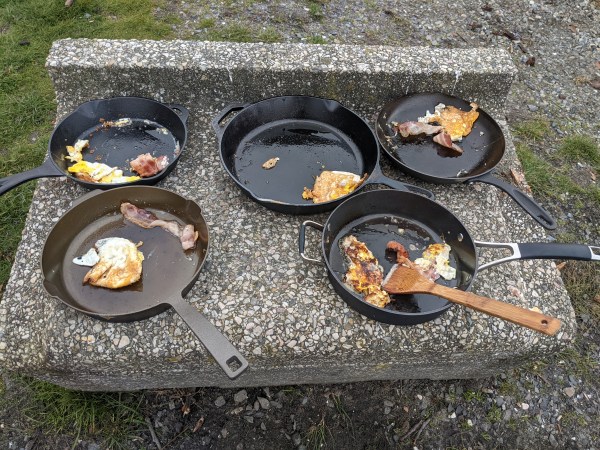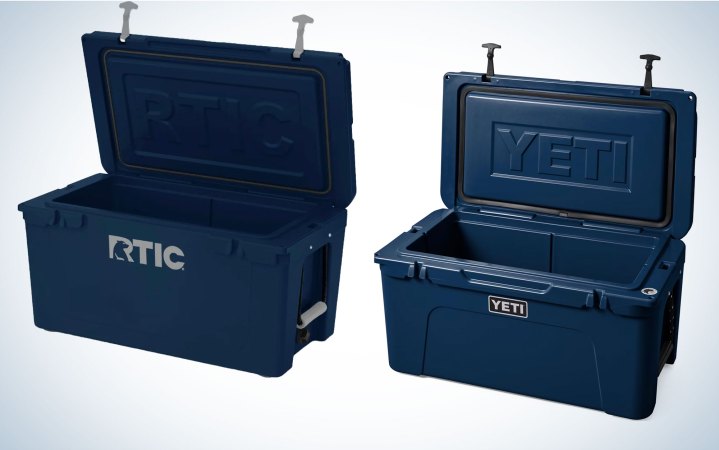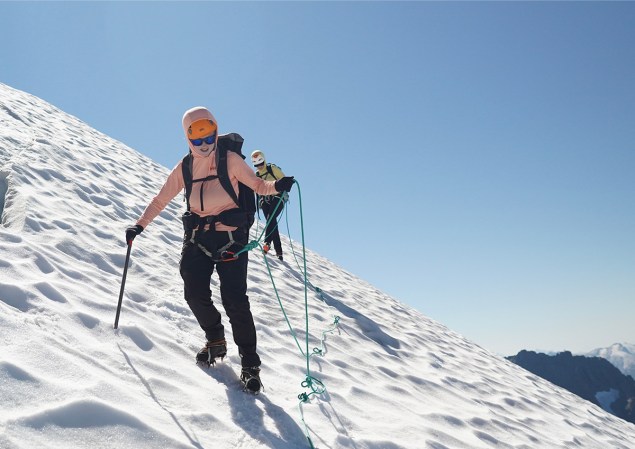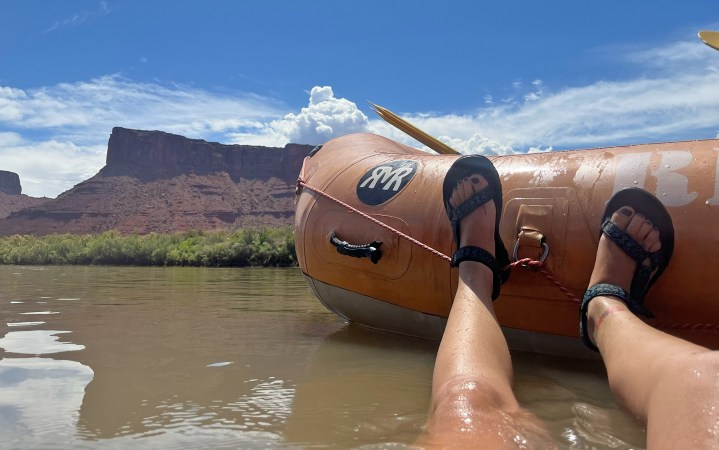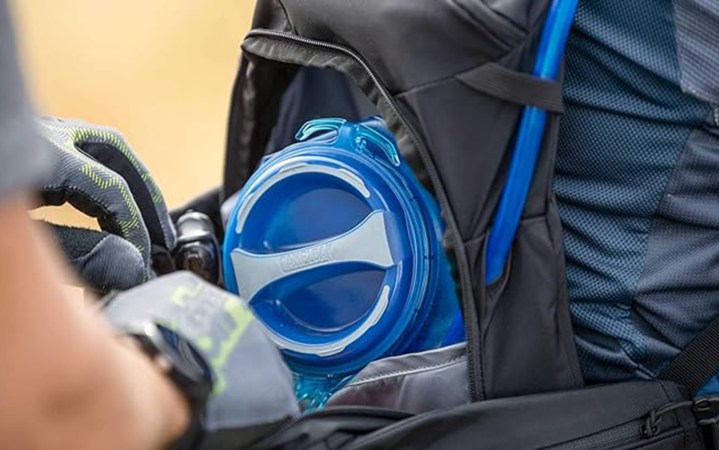We may earn revenue from the products available on this page and participate in affiliate programs. Learn More ›
There are a few different flavors of wilderness camping, but typically, the term refers to simply camping in the backcountry. That is, camping in a place that you have to hike at least a few miles to, leaving the smoggy tailpipes and gurgling RVs of car camping far behind (along with flush toilets, sinks, and trash services).
In some backcountry areas — typically in National Parks — wilderness camping is permitted only in designated backcountry campgrounds. These campgrounds may require reservations, and have amenities such as fire rings, pit toilets, and even rustic shelters to protect campers from extreme weather. To some, this level of infrastructure applied to wilderness camping might be frustrating (it is ironic to make a reservation for an experience that’s supposed to make you feel free from bureaucracy). But these systems and amenities are typically only in place because of high human use. When backpackers agree to camp in the same areas, we limit the impact on the land, help maintain the illusion that we are walking in a primordial wilderness utopia, and best of all, avoid seeing each other poop.
Most of the time, however, when people think of wilderness camping, they think of dispersed camping. Dispersed camping is when you make your own campsite in the backcountry wherever you see fit – no bathrooms, no fire rings, no reservations. It’s just you, the wild, and whatever you brought on your back. Dispersed camping can be an unparalleled communion with nature, or a complete nightmare. Here are some tips to make the most of the experience.
Where to Camp in the Wilderness
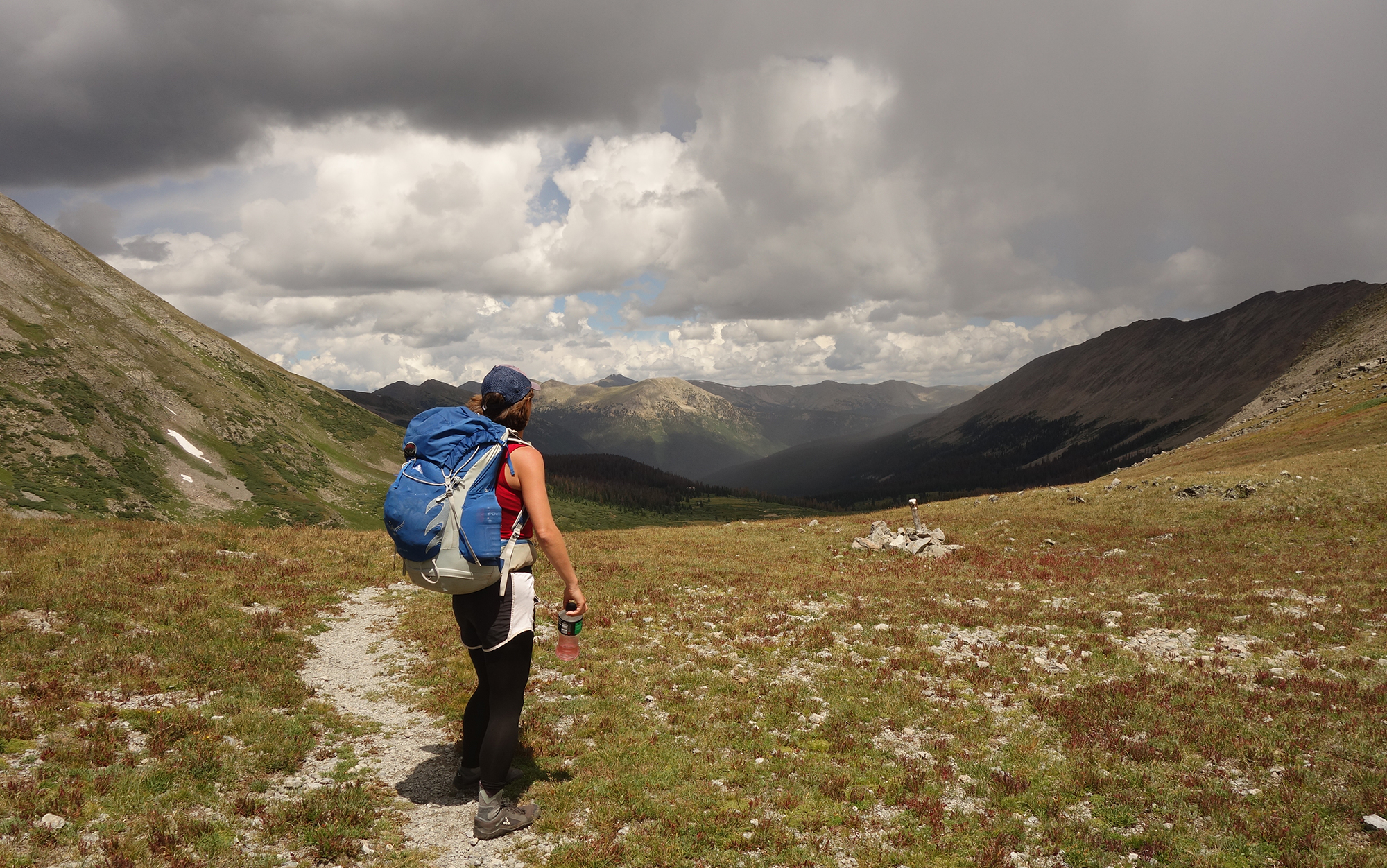
We’ve already established that you can’t just set up your wilderness camp anywhere. Public lands have different designations and rules around camping. Here are some types of public land that commonly allow wilderness camping and what you should know about each. Always make sure to check the regulations for the specific place you intend to camp, as rules vary.
- National Parks: Usually require reservations and permits
- National Forests: Often allow dispersed camping
- Wilderness Areas: Often allow dispersed camping, have special regulations around gear and technology
- Bureau of Land Management Land: Often allows dispersed camping
- State Forests: Some allow dispersed camping, some do not
- State Parks: Usually require reservations and permits similar to national parks
- Wild & Scenic Rivers: Commonly have paddle-in or boat-in campsites and special regulations
Read Next: Where to Go Camping
How to Pick a Campsite
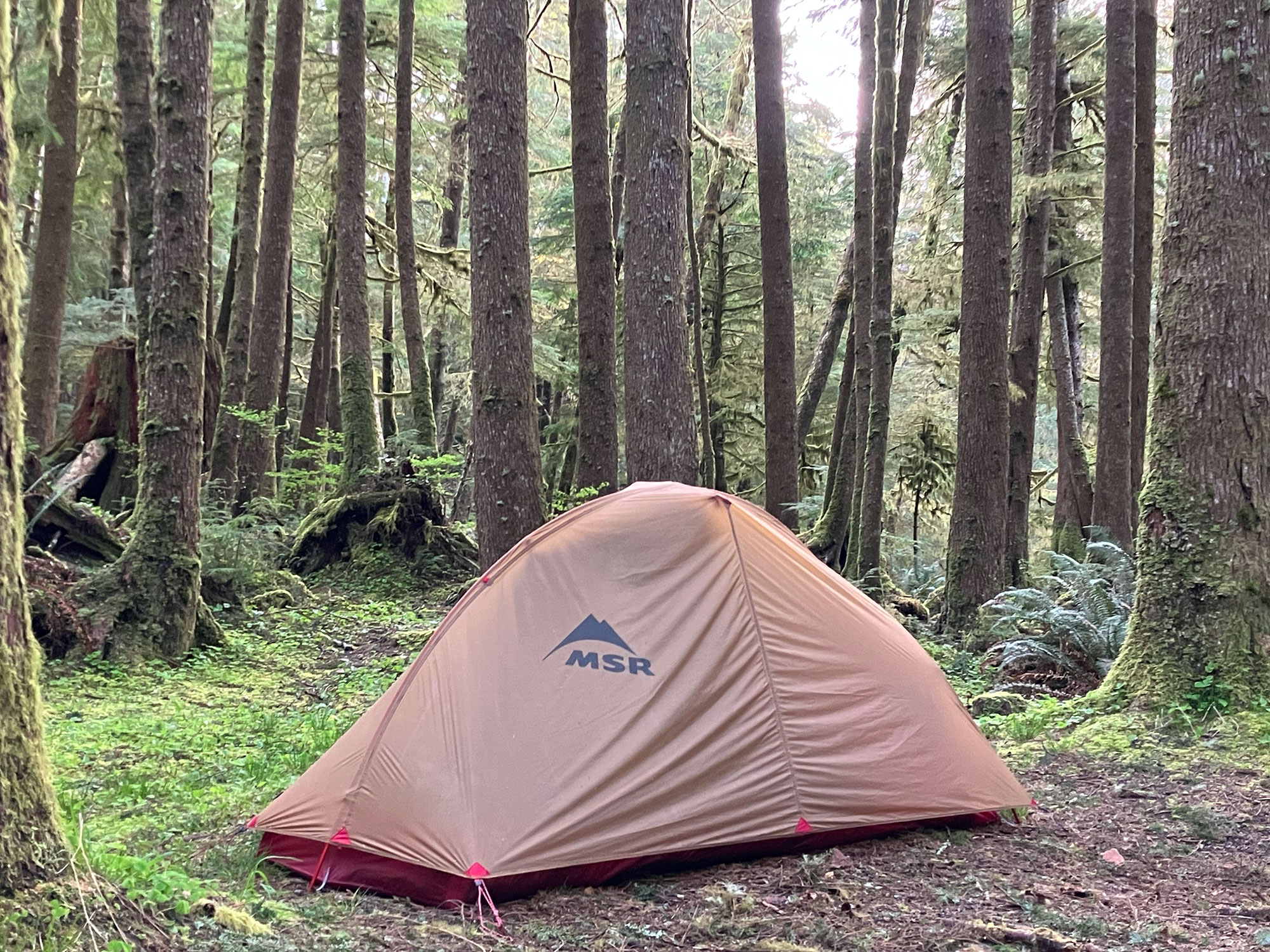
When I’m backpacking, I try to end every day near a body of water, whether it’s a grand lake or a seasonal creek. It makes it easier to start and end the day without having to worry about hydration, and it’s nice to give your feet a soak as thanks for their hard work. However, when you camp near water, keep in mind Leave No Trace: do not pitch a tent, cook, or poop within 200 feet of a water source. This might sound annoying, but it helps us keep fecal bacteria out of each other’s water, and maintains the delicate flora balance present in wild water sources. It’s also a smart idea to keep your cooking area some distance from your sleeping area. If a curious bear comes to sniff around at night, I personally find it much more comforting knowing there is some distance between my jugular and the lingering scent of macaroni and cheese.
Use Established Campsites
Your backpacking map may have suggested backcountry camps listed along your route already. Even if you are not required to sleep there by threat of a fine, it’s usually a good idea to take advantage of them. Not only will you limit human impact on the land, but, frankly, it’s much easier than making your own site. Someone probably already cleared away most of the debris that would stick into your back at night, removed structures that could fall on you, and found one of the better views around. In short, others have done most of the thinking for you.
Backcountry campsites on a map may or may not have actual signs on the ground, but you’ll know them when you see them. Keep an eye out for patches of ground that look starkly flat and unusually barren of flora — almost like multiple people have pitched tents there and then laid down all night.
Find Unmarked Sites
If you’re backpacking in a less popular wilderness area, your map may not have any suggested camp areas at all. This is where the art of making your own campsite comes in. However, despite two decades of backpacking, I have almost never had to do this. Even if a campsite isn’t officially listed on a backcountry map, an “unofficial” one almost always exists – especially near large bodies of water, or landmarks of significance. Say you run into a rather majestic rockscape that crosses the trail eight miles from the trailhead. You might notice a few barren patches of dirt amidst the grass, tucked behind some trees, about 100 feet from the trail. That, my friend, is a backcountry campsite. Or maybe 20 miles in, there’s an iconic lake, the only one around for miles. I can almost guarantee, if you circumnavigate the shoreline, you will find some unnaturally smooth patches of ground, a circle of charred stones, and a seat-sized rock someone has clearly dragged over; evidence of campsites past.
Establish Your Own Campsite
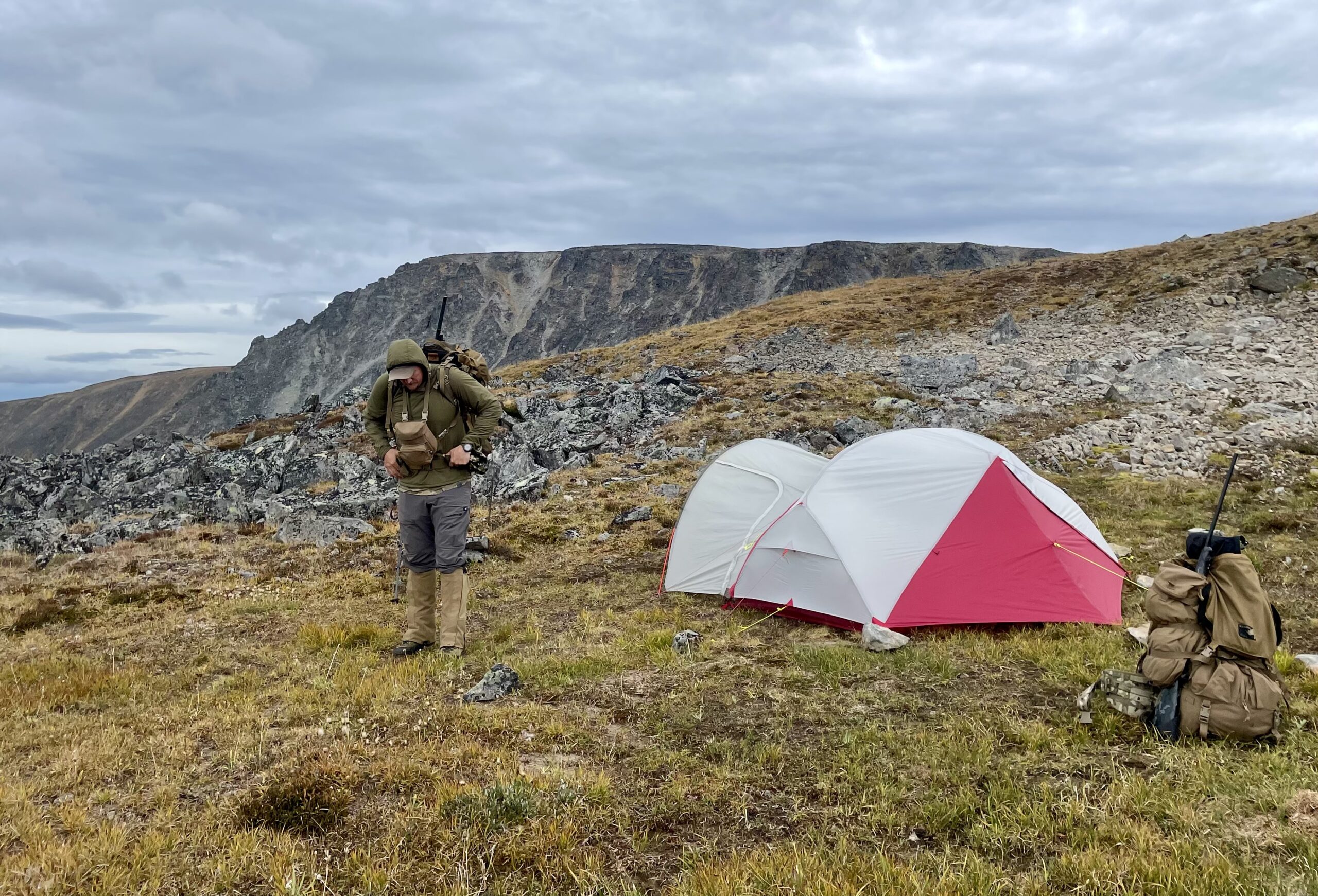
Truly creating your own campsite is something you should only do as a last resort. Frankly, it’s a bit of a pain to find a place with the magical combination of ingredients that make up a good backcountry campsite: near the trail (but not less than 100 feet), relatively flat, protected from wind, spacious enough for you to set up your cooking area, your cleaning area, and your sleeping area away from each other, devoid of “widow makers” (aka dead trees that could fall on you in the night), and near water (but not closer than 200 feet). Most established campsites, even unofficial ones, have already ticked these boxes, which is why it’s easier to simply use them.
If you are absolutely certain no campsite exists where you need to spend the night, in addition to the Leave No Trace and safety rules mentioned above, keep these other pointers in mind:
- Know that the closer you sleep to water, the colder and more susceptible to animal life you will be.
- Sleeping in dry washes and dry riverbeds, especially in an area that can have flash floods, can easily put you in the direct path of a rush of water if a storm hits in the middle of the night.
- To stay warm, avoid sleeping in any dips, dells, or washes, as cold air will sink and settle into them (and onto you). Basically, no matter what, it’s good practice to avoid sleeping in anything that resembles a ditch.
- Avoid camping on any open ridges or cliffs, so you won’t be at the full mercy of any wind gusts that decide to crash your party.
- It’s best to find some middle ground in the landscape you’re currently in, at least 100 feet from the trail, and 200 feet from any water sources.
- Finally, no matter where you camp, keep an eye out for large, dead trees, and ensure you are not in the path of the direction they might fall.
How to Sleep Well in the Backcountry
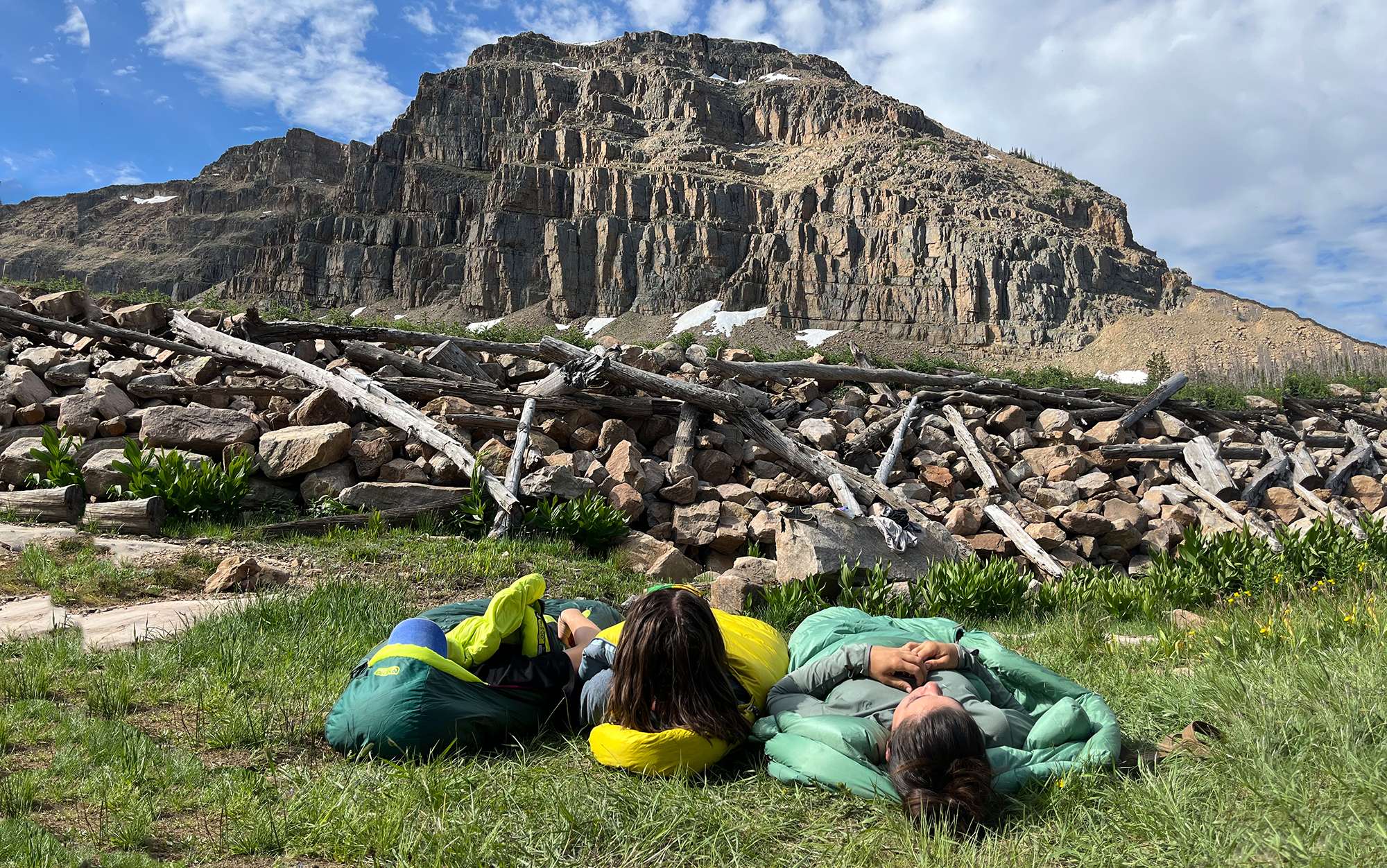
To ensure you have a comfortable night outdoors, the main things to consider are your shelter and your sleep system. Temperatures and weather patterns in the backcountry are never 100% predictable, but it is imperative that you at least have an idea of the possible weather you’re going to be sleeping in. The sleep system you need in an area where you might encounter freezing rain is very different from the sleep system you can get away with if you expect clear skies and an overnight low of 58.
Wilderness Camping Shelters
There are a variety of shelters and sleep systems available, and if you can afford multiple options, it’s worth it. But pretty much no matter what terrain you’ll be hiking through, or in what weather pattern you end up sleeping in, a tent can be pitched, which is why it’s the only shelter system I use.
With that said, I have never heard of a backpacker who viewed another backpacker’s shelter and said “that’s a great idea, I have no ideas or suggestions to add as to how you could improve that system.” Along with shoes, selecting a shelter and sleep system is one of the biggest topics up for debate in the backpacking community. Here are some options.
Tents
Backpacking tents tend to increase in price as they decrease in size and weight. A tent can easily take up a huge section of your pack. They can also be heavy and annoying. But, like most people who have had their eyelid bitten by a mosquito in the middle of the night, I prefer to sleep inside something that I can zip up around my entire body, with a rainfly big enough to keep my pack and shoes dry overnight (from either condensation or rain).
This is not the only way to make yourself a shelter in the backcountry though.
Tarps
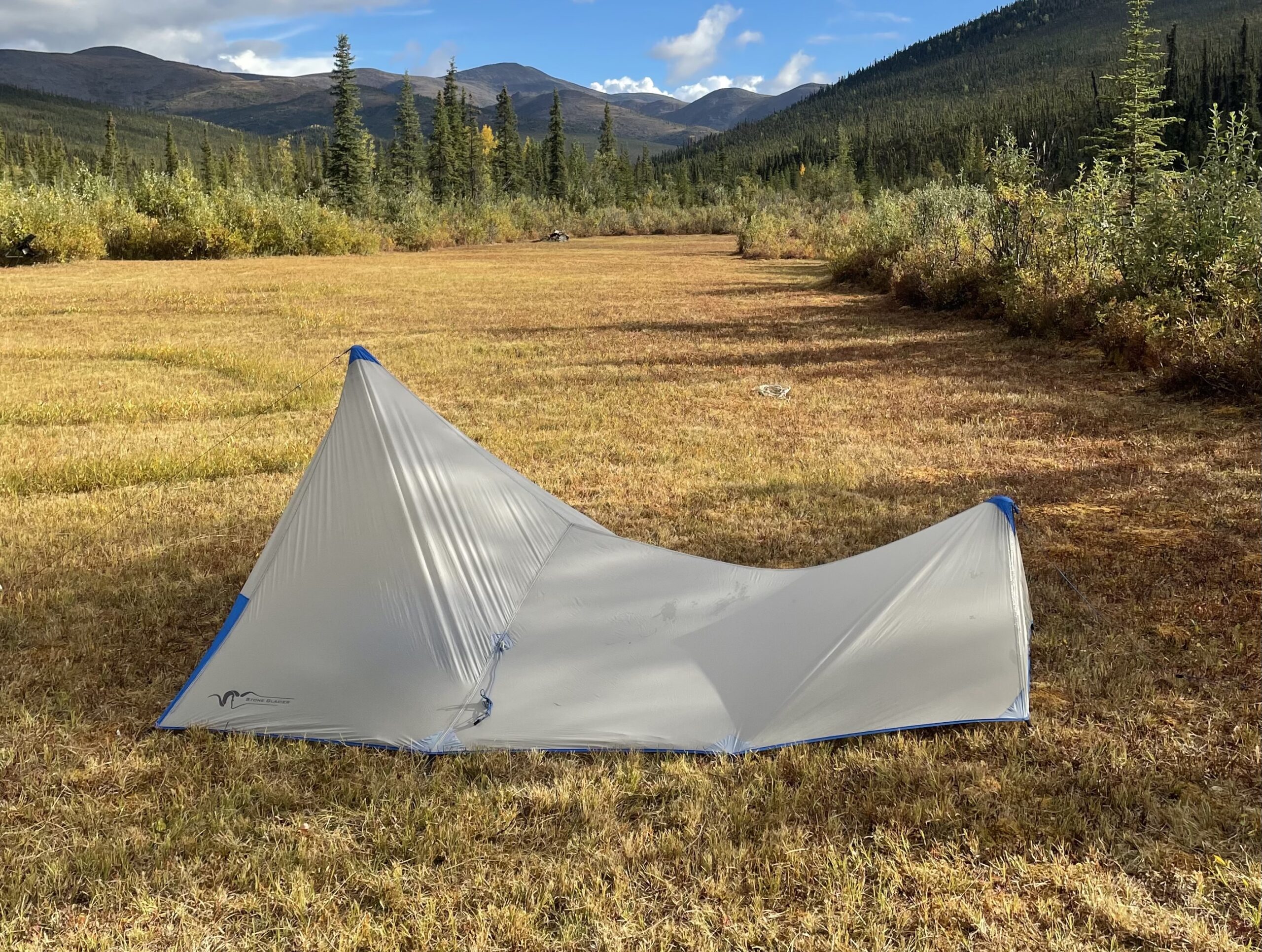
A way to avoid the bulk and expense of a tent is to stretch a lightweight camping tarp between trees or sticks, either as a lean-to, or just as a ceiling. I admire the minimalism of those who camp under nothing but a tarp. Although a tarp will keep rain off your gear and your body, it does allow every cold breeze to catch you in a vice grip, and every curious critter can walk right up and give your crotch a good sniff in the middle of the night, should they so choose.
Hammocks
Another alternative to the tent is the backcountry hammock. Little more than a few fistfuls of cloth, paracord, mesh overlay and carabiners in your pack is all you need for a good night’s sleep. You simply lash the cloth between two trees, climb in like a baby kangaroo, and lay the mesh over yourself like a death shroud. The only time a hammock will fail you is if you’re camping above the tree line. (Also, I’m not sure crotch-sniffing mammals are deterred by hammocks, either).
Wilderness Camping Sleeping Bags and Quilts
Sleeping Bags
For a long time, the mummy sleeping bag was essentially standard issue in backpacking. A mummy bag is exactly what it sounds like: a puffy tube in the tapered shape of a dead Egyptian aristocrat. To get in, you lay it out flat, unzip it, slide yourself in, bend forward, zip it up as much as you can, lie back down, continue zipping it up, and then tug on the interior bungee cords until your shoulders are pinned to your body, like they would be while wearing a straightjacket. You then insert your head into the bonnet attached to the top of the bag and shimmy your hands up to pull the bonnet’s bungee straps down until your lips, nose, and eyes are the only things exposed to the soulless, frigid night. Then you sleep.
Sleeping Quilts
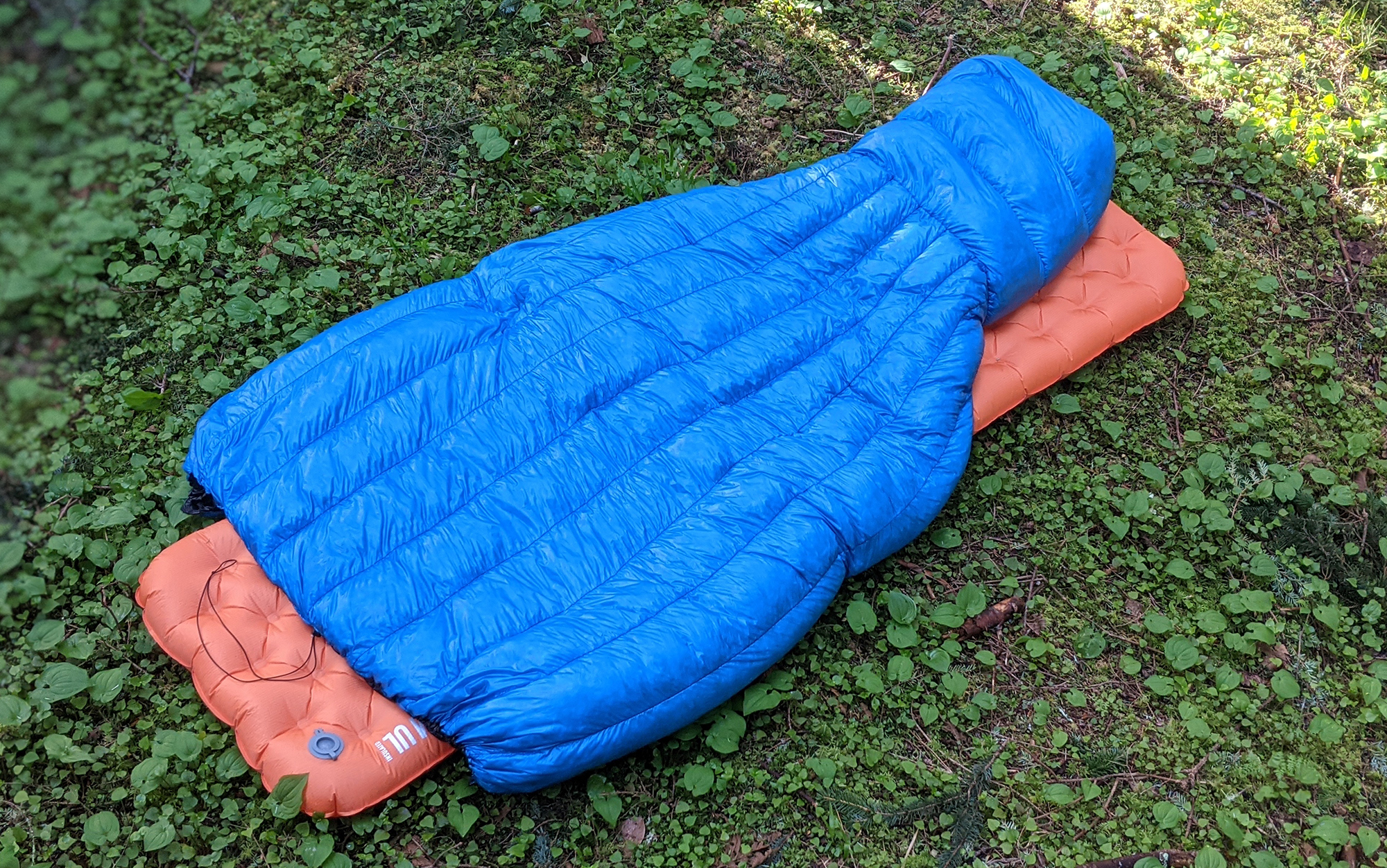
Sleeping quilts have attempted to solve some of the discomforts of sleeping bags. A sleeping quilt is essentially a sleeping bag with a back that has been replaced by open air and a series of bungee straps. You slide the bag’s bungee cords over a sleeping pad, creating an envelope for your body to slip inside and sleep comfortably. In a quilt, you tend to have a greater range of motion (and a less dramatic time getting in and out) than with a mummy bag. The catch is that high quality sleeping quilts tend to be more expensive than high quality sleeping bags.
Temperature Ratings
Whether you opt for a bag or a quilt, be sure to note its temperature rating – that is, the temperature it is designed to keep you comfortable in (or, at least, alive). The idea here is to make sure you’re not taking a bag rated for 40 degrees into a zone where you could encounter 20 degree temperatures. For this reason, if you’re buying a bag for the first time, it’s always a good idea to get one rated for as low a temperature as you can afford (the warmer the bag, the more expensive it will be). In the backcountry, it’s easy to unzip and vent out a too-warm sleeping bag. It’s impossible to add more fill.
The temperature value of your bag/quilt is only one half of the warmth equation though. The other is the R-value of your sleeping pad. Sleeping bags and quilts acquire their temperature ratings while being tested with a sleeping pad that has a particular r-value (a measurement of how well the pad stops cold seeping up from the ground). For example, a sleeping bag with a 32 degree comfort rating will only keep you comfortable at 32 if you pair it with a sleeping pad that has the same R-value with which it was tested. Of course, it can be very difficult to know the R-value that was used during a bag’s testing. The easiest way around this problem? Invest in a sleeping pad with a high R-value rating, so you can enjoy the maximum capabilities of your bag or quilt.
If you are strapped for funds, a great way to improve any sleep system’s warmth is by simply adding a sleeping bag liner – a thin sheet pocket that fits inside your bag or quilt, typically made of polyester. They can be a pain to get in and out of, and will add a few ounces to your pack, but they are also an extraordinarily affordable way to get 5 to 10 more degrees out of any sleep system (which can make a huge difference between insomnia and restful sleep).
Final Thoughts on Camping in the Wilderness
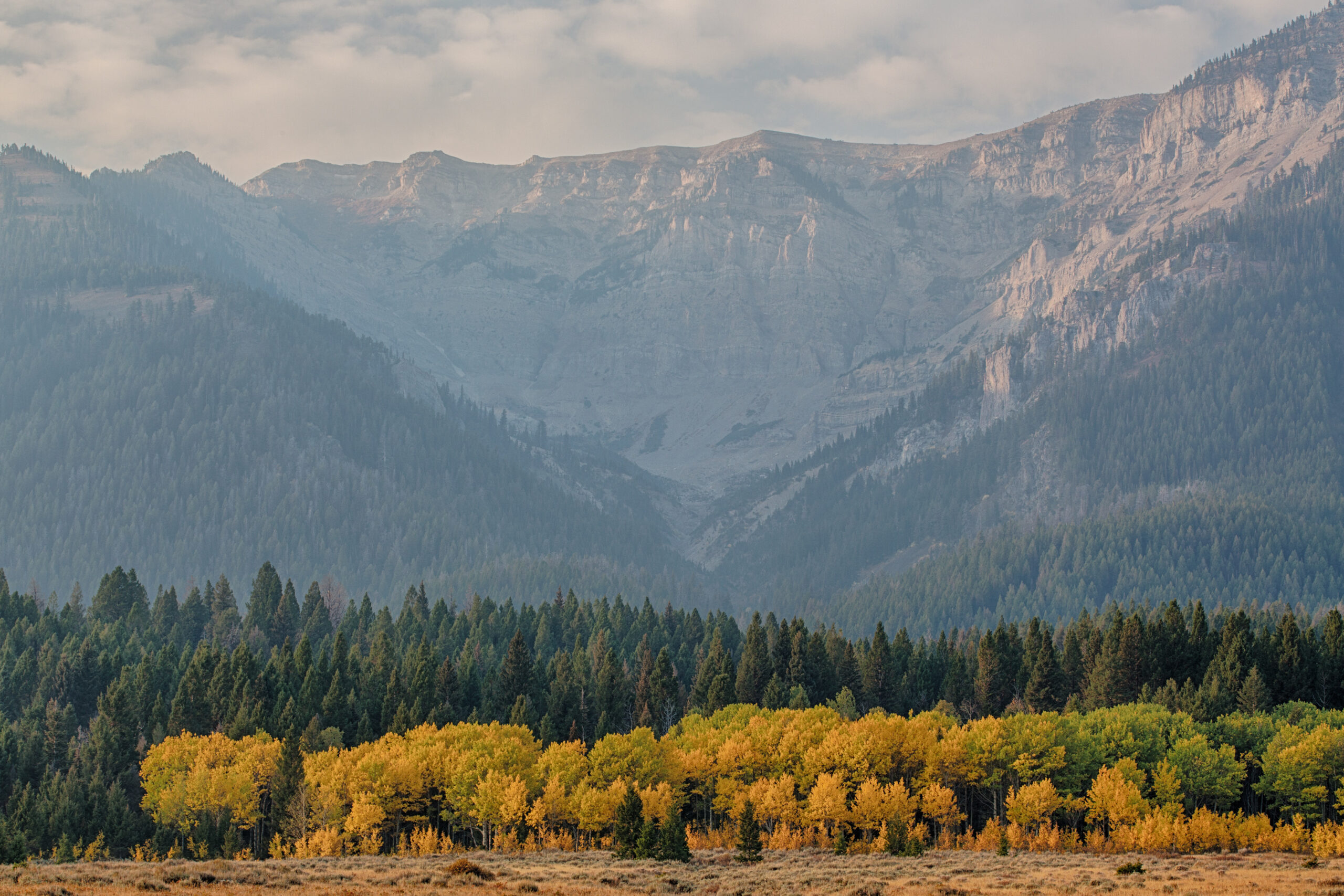
Wilderness camping can be one of the best parts of backpacking; there is nothing more beautiful than watching the sunrise from your own temporary homestead (even if it is mostly nylon based). When leaving any wilderness camp, the last and possibly most important rule is to pack out everything you brought, from protein bar packaging scraps to tent stakes. This way, the next person who comes into camp can enjoy the same pristine experience that you enjoyed.

